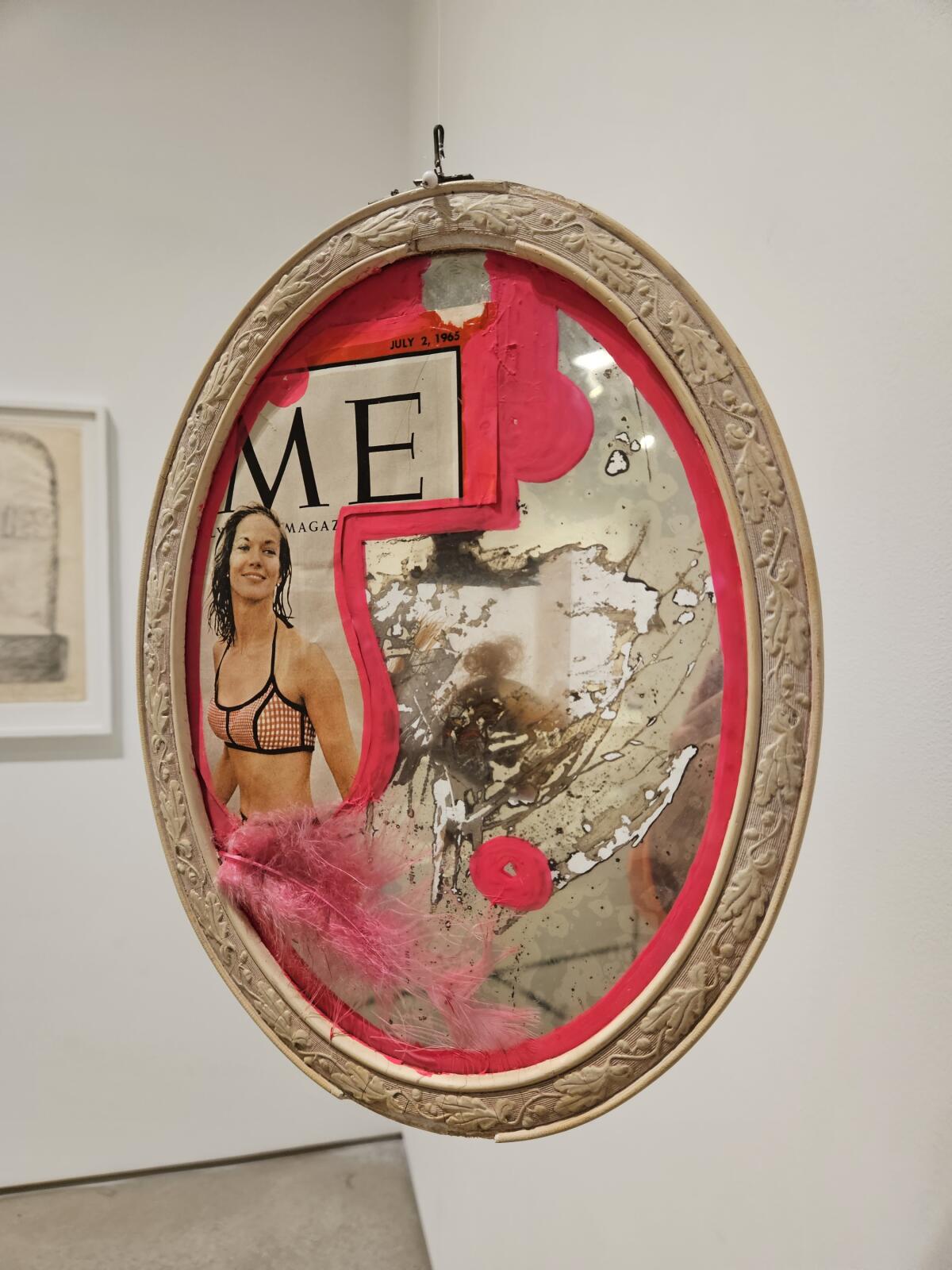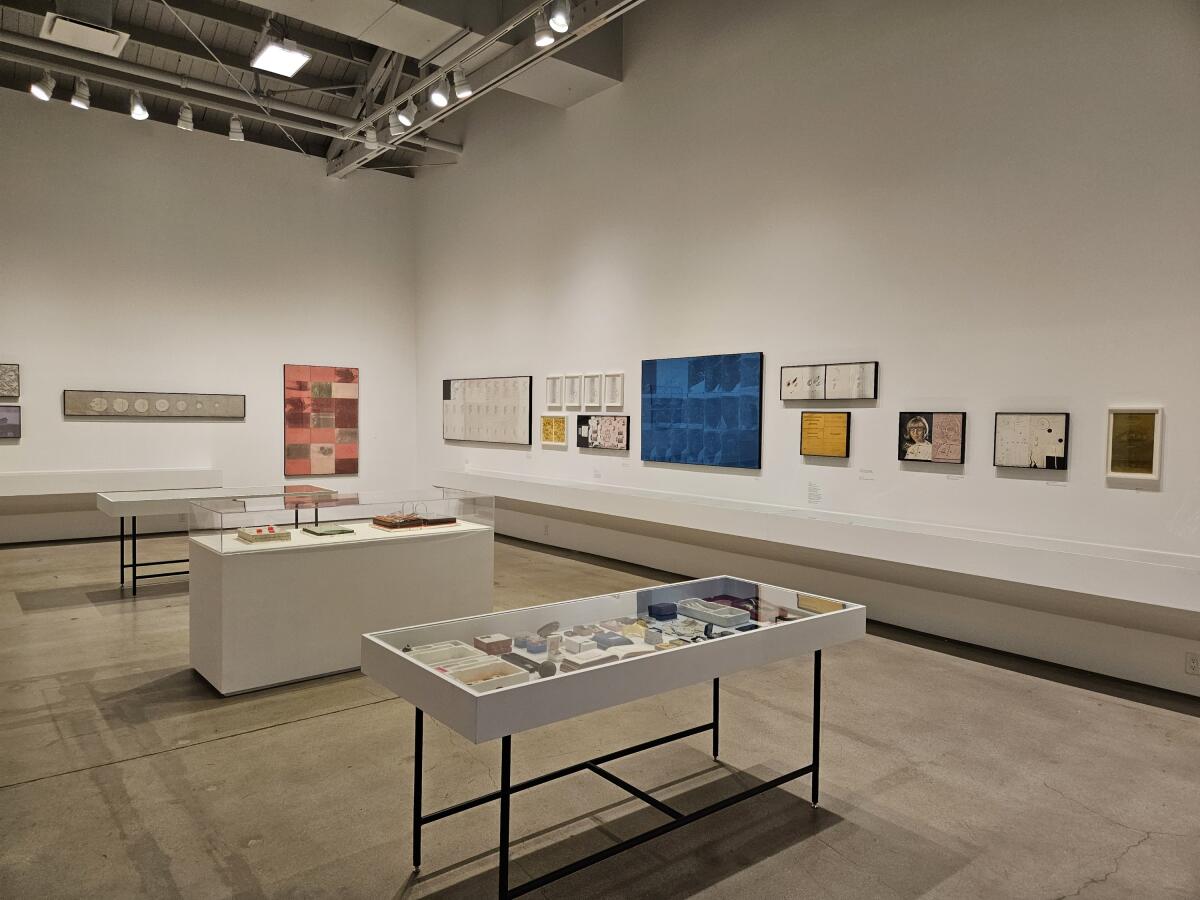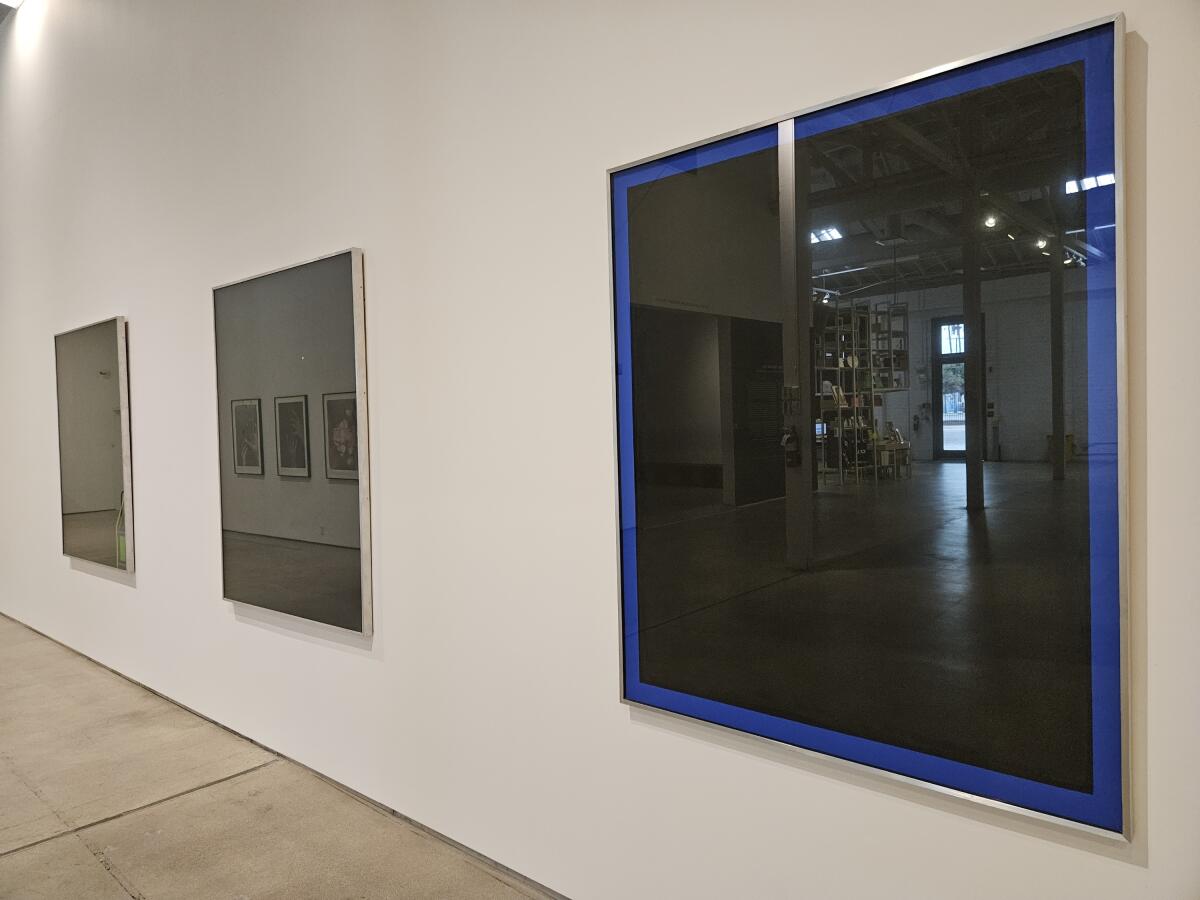“Me” is the straightforward, declarative title of a small self-portrait of Barbara T. Smith that’s suspended from the ceiling close to the doorway to her absorbing retrospective exhibition at downtown’s Institute of Up to date Artwork, Los Angeles.
An assemblage sculpture, it encompasses a fragment of a Time journal cowl with the “TI” clipped off, leaving simply “ME” behind. A line of pink paint circles the sting of the body and a fluffy pink feather is hooked up close to the underside.
The July 1964 Time journal cowl introduced an inside unfold on the perfect summer time trip resorts within the U.S. Pictured is a casually glamorous younger lady striding throughout the shore at pricy Sea Island, Ga., hair moist and sporting a bikini. A neighborhood, not a mannequin, the girl’s identify was Michael Anderson — a considerably unusual gender combine.
Smith positioned the pink feather to cowl the swimsuit’s backside. It’s as if the mass-circulation journal cowl conceived of Anderson as an unique dancer, a industrial leisure attraction framed for a readership presumed to have straight male wishes.
“That’s me,” says Smith’s mirror, which is dated 1964-65.

Barbara T. Smith, “Me,” 1964-65, combined media (recto).
(Christopher Knight / Los Angeles Occasions)
Who Smith was wasn’t precisely clear. Then 33, daughter of a profitable Pasadena mortician; married to a businessman who had been her high-achieving, highschool sweetheart; mother to a few children — Smith has stated she was exploring the rising liberation motion that got here to be known as second-wave feminism, wherein her identification wouldn’t be circumscribed as solely daughter, spouse and mom. A volunteer on the outdated Pasadena Artwork Museum, which was shaking issues up with exhibitions of Marcel Duchamp’s Dada excessive jinks and Pop portray and sculpture, she was nonetheless new to artwork. That the little assemblage took at the least six months to make means that the artist’s self-perception was in appreciable flux.
So does her specific alternative of photographic illustration on the journal cowl. A bather is nearly as basic as an artwork motif will get.
One apparent rationalization for its endurance is {that a} bather gives an excuse to point out a little bit of pores and skin, giving the work a sensual kick. In Western tradition, the recognition of bathers as creative topics tends to rise in periods of upheaval or main transition — through the Renaissance, for instance, or on the finish of the nineteenth century. Bathers have been an anchor to assist stabilize main social change, all whereas pushing in a brand new route. The topic carries a symbolic operate: The tub is an act of cleaning — of beginning recent.
Sunny Los Angeles was the forefront of bather artwork within the boisterous Sixties, led by British expat David Hockney, who was busy portray luxurious photos of males in showers and lounging round swimming swimming pools. Smith’s extra tentative however absolutely astute bather suits proper in.

Barbara T. Smith, “Me,” 1964-65, combined media (verso)
(Christopher Knight / Los Angeles Occasions)
And there’s extra: Since her self-portrait assemblage is suspended in house, its again is as seen because the entrance. The again of “Me” is encircled by a string of pearls. On the middle of the oval panel is the severed head of a plastic doll. Caught dangling from the highest is a remnant of newfangled instant-camera movie. Polaroid had launched peel-apart colour prints the yr earlier than, in 1963, and the do-it-yourself revolution in image-making was on.
Time journal would possibly supply a company picture of female roles outlined for a mass viewers, however Smith’s savvy work appears to signify a resolve to create her personal. “Me,” which I hadn’t seen earlier than, all I may assume was: “Barbie,” the film, is tremendous, nevertheless it hasn’t acquired a factor on Barbara, the artist.
Organized by visitor curator Jenelle Porter, the exhibition is the second installment of what T-shirts within the present store rejoice as “The Yr of Barbara.” Now 92, Smith was the topic of an autobiographical exhibition on the Getty Analysis Institute — her first main museum present — that ran from February to July. The GRI holds a big archive of Smith’s papers, and it revealed her memoir, “The Solution to Be,” masking the primary 50 years of her life.
A giant chunk of that archive consists of the so-called “Coffin collection” — Xerox books begun in 1966, wherein Smith experimented with photocopying images, extraordinary family objects and fragments of her personal physique. They’re prints, albeit made with up-to-date workplace equipment somewhat than conventional etching plates or lithography stones.
For just a few years, artist Wallace Berman had been utilizing an old style Verifax copy machine to make extraordinary artwork with a mysterious non secular dimension; however the truth that his copier gadget represented an out of date know-how, outdated within the fast-moving world of capitalist enterprise, was vital to his spectral, mystical imagery. Smith’s artwork is totally different, given the ability of mega-corporate Xerox.

A big choice from the 1000’s of Xerox prints Barbara T. Smith made in 1966 are in her ICA LA retrospective.
(Christopher Knight / Los Angeles Occasions)
Smith rented a copier, set it up in her eating room at residence and made tens of 1000’s of Xerox prints. A big choice on the ICA reveals her working towards the machine’s typical workplace operate.
She produced data of private reminiscences, children’ video games, home narratives, non-public snapshots, erotic indulgences and extra. Something that undermined the same old enterprise utility appears to have been the goal. For her, a household party was an equal to the Acme Widget Co. annual report, whereas portraits of relations have been simply as vital as stuffy photos of the board of administrators. Even titling her Xerox books as “Coffins” is personalised, recalling Smith’s mortician-father.
Codecs embrace thickly sure volumes, particular person collaged sheets and framed grids that repeat the identical picture 20 or 30 instances. The repetitions discovered within the latter motif quickly could be consecrated on the Pasadena Artwork Museum in “Serial Imagery,” a landmark exhibition that surveyed all the pieces from Claude Monet’s Rouen Cathedral work to Andy Warhol’s soup cans — however no artwork by any girls, together with Smith. The Xerox print manufacturing got here to a commemorative finish with “Upon the Completion of a Love Affair With a Machine,” an unassuming assemblage composed of a pastoral jigsaw puzzle piece displaying grazing cows that’s hooked up to an empty tattered field for copy paper.
The Getty exhibition emphasised Smith’s function as a pioneer in efficiency artwork, a style so new within the early Nineteen Seventies that it hadn’t but acquired a reputation. The present present encompasses the total sweep of her profession. Essentially the most fascinating sections survey the primary 15 to twenty years as efficiency emerged. Within the Nineteen Eighties, as Smith delved deep into Japanese philosophy, her artwork turned extra obscure, whereas within the Nineteen Nineties her manufacturing decreased, following the sickness and demise of her son from AIDS.

Barbara T. Smith, “Trunk Piece,” 1969-72, combined media.
(Christopher Knight / Los Angeles Occasions)
On the ICA, these and different points of her six-decade profession are concisely organized by eight framed video flat-screens accompanied by a quick little bit of explanatory textual content. Objects are displayed as a form of efficiency residue. “Trunk Piece,” a chest filled with remnants from the sophisticated fabrication of a walk-in setting, way back destroyed, known as “Discipline Piece,” for instance, is itself a form of coffin.
Essentially the most lovely bodily object is definitely the casting mildew for a sculpture of the rind of an infinite winter squash, introduced as a reliquary atop a rough-hewn altar, that was the centerpiece of an uninhibited 1971 efficiency. (The resin sculpture is close by.) “The Celebration of the Holy Squash” was a weeklong feminist parody of a pious ceremony, nevertheless it took significantly a lady’s function as agent of communal ritual. The occasion centered on an elaborate feast at which friends devoured candy Hubbard squash, a logo of abundance and fertility, fastidiously ready for consumption. The solid resin squash made light enjoyable of the commercial, aerospace underpinnings of Mild & House artwork, which featured solid resin geometric varieties. Its iridescent casting mildew appears to be like nearly like a chrysalis awaiting the emergence of a monumental butterfly.
After the ritual efficiency, the artist positioned a discover in a neighborhood authorized publication declaring the formation of a brand new faith. Not broadly recognized now, however a controversial work when introduced as her grasp’s diploma exhibition at UC Irvine, Smith’s playful and witty efficiency predated by greater than three years fellow L.A. artist Judy Chicago’s fabrication of the ponderous “The Dinner Celebration,” her well-known, altar-like set up sculpture.

Barbara T. Smith’s 1965 “Black Glass Work” mirror their environment.
(Christopher Knight / Los Angeles Occasions)
The retrospective opens with three shocking work that recommend how Smith transitioned away from conventional objects into performances, usually centered on the human physique. Made in 1965, 5-square-foot canvases painted matte black are framed behind thick, reflective glass. One is edged in strips of royal blue; one other sports activities a single tiny spot of white paint close to the highest; and a 3rd encompasses a small community of geometric colour bands in a decrease nook.
The “Black Glass” work are little doubt indebted to Duchamp’s well-known “The Bride Stripped Naked by Her Bachelors, Even” (1915-23), the clear mixed-media sculpture nicknamed “The Massive Glass” that Smith encountered as a volunteer on the Pasadena Museum. Look intently, and the blackness, visually impenetrable however unusually mushy, has been achieved by making use of Rothko-like veils of layered pigment.
Not that wanting intently is straightforward, thoughts you, since your face retains getting in the best way. The black-backed glass transforms every portray right into a digital mirror, which displays its context — at the beginning, the particular person standing earlier than it.
In them, you see your self making an attempt onerous to see. That’s the exploratory scaffolding on which Smith constructed her most participating artwork.
“Barbara T. Smith: Proof”
The place: ICA LA, 1717 E. seventh St.
When: Wednesdays and Fridays midday to six p.m., Thursdays midday to 7 p.m., Saturdays and Sundays 11 a.m. to six p.m. Runs by means of Jan. 14.
Information: (213) 928-0833, theicala.org
#Artist #Barbara #Smith #museum #retrospective #ICA
